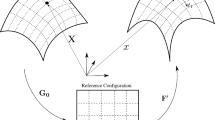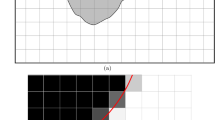Abstract
Red blood cells (RBCs) are the most common type of blood cells in the blood and 99 % of the blood cells are RBCs. During the circulation of blood in the cardiovascular network, RBCs squeeze through the tiny blood vessels (capillaries). They exhibit various types of motions and deformed shapes, when flowing through these capillaries with diameters varying between 5 and 10 µm. RBCs occupy about 45 % of the whole blood volume and the interaction between the RBCs directly influences on the motion and the deformation of the RBCs. However, most of the previous numerical studies have explored the motion and deformation of a single RBC when the interaction between RBCs has been neglected. In this study, motion and deformation of two 2D (two-dimensional) RBCs in capillaries are comprehensively explored using a coupled smoothed particle hydrodynamics (SPH) and discrete element method (DEM) model. In order to clearly model the interactions between RBCs, only two RBCs are considered in this study even though blood with RBCs is continuously flowing through the blood vessels. A spring network based on the DEM is employed to model the viscoelastic membrane of the RBC while the inside and outside fluid of RBC is modelled by SPH. The effect of the initial distance between two RBCs, membrane bending stiffness (K b ) of one RBC and undeformed diameter of one RBC on the motion and deformation of both RBCs in a uniform capillary is studied. Finally, the deformation behavior of two RBCs in a stenosed capillary is also examined. Simulation results reveal that the interaction between RBCs has significant influence on their motion and deformation.




























Similar content being viewed by others
References
Bayliss, L.: The axial drift of the red cells when blood flows in a narrow tube. J. Physiol 149(3), 593–613 (1959). doi:10.1113/jphysiol.1959.sp006363
Cooke, B.M., Mohandas, N., Coppel, R.L.: The malaria-infected red blood cell: structural and functional changes. Adv. Parasitol. 50, 1–86 (2001). doi:10.1016/S0065-308X(01)50029-9
Dupire, J., Socol, M., Viallat, A.: Full dynamics of a red blood cell in shear flow. Proc. Natl. Acad. Sci. 109(51), 20808–20813 (2012). doi:10.1073/pnas.1210236109
Fåhræus R, Lindqvist T.: The viscosity of the blood in narrow capillary tubes. Am. J. Physiol. Legacy Cont. 96(3):562–568. http://ajplegacy.physiology.org/content/96/3/562
Fedosov, D.A., Lei, H., Caswell, B., Suresh, S., Karniadakis, G.E.: Multiscale modeling of red blood cell mechanics and blood flow in malaria. PLoS Comput. Biol. 7(12), e1002270 (2011). doi:10.1371/journal.pcbi.1002270
Frcitas, R.A.: Exploratory design in medical nanotechnology: a mechanical artificial red cell. Artif. Cells Blood Substit. Biotechnol. 26(4), 411–430 (1998). doi:10.3109/10731199809117682
Hou, H.W., Li, Q., Lee, G., Kumar, A., Ong, C., Lim, C.T.: Deformability study of breast cancer cells using microfluidics. Biomed. Microdevices 11(3), 557–564 (2009). doi:10.1007/s10544-008-9262-8
Jiang, X.M., Wang, T., Xing, Z.W.: Simulation Study of Hemodynamics of Red Blood Cells in Stenotic Microvessels. Adv. Mater. Res. 647, 321–324 (2013). doi:10.4028/www.scientific.net/AMR.647.321
Kaoui, B., Harting, J., Misbah, C.: Two-dimensional vesicle dynamics under shear flow: effect of confinement. Phys. Rev. E 83(6), 066319 (2011). doi:10.1103/PhysRevE.83.066319
Le, D.-V., White, J., Peraire, J., Lim, K., Khoo, B.: An implicit immersed boundary method for three-dimensional fluid–membrane interactions. J. Comput. Phys. 228(22), 8427–8445 (2009). doi: 10.1016/j.jcp.2009.08.018
Liu, G.R., Liu, M.: Smoothed particle hydrodynamics: a meshfree particle method. World Scientific Publishing Company Incorporated, (2003)
Morris, J.P., Fox, P.J., Zhu, Y.: Modeling low Reynolds number incompressible flows using SPH. J. Comput. Phys. 136(1), 214–226 (1997). doi:10.1006/jcph.1997.5776
Nagayama, K., Honda, K.: 3D Particle Simulations of Deformation of Red Blood Cells in Micro-Capillary Vessel. (2012)
Pan, T.W., Wang, T.: Dynamical simulation of red blood cell rheology in microvessels. Int. J. Numer Anal Model. 6, 455-473 (2009). http://www.math.ualberta.ca/ijnam/Volume-6-2009/No-3-09/2009-03-07.pdf
Polwaththe-Gallage, H.-N., Saha, S.C., Sauret, E., Flower, R., Gu, Y.: Numerical Investigation of Motion and Deformation of a Single Red Blood Cell in a Stenosed Capillary. Int. J. Comput. Methods, 1540003 (2015)
Polwaththe-Gallage, H.N., Gu, Y., Saha, S.C., Senadeera, W., Oloyede, A.: (2012) Numerical simulation of red blood cells’ motion : a review. Paper presented at the 4th International Conference on Computational Methods (ICCM: Crowne Plaza. Gold Coast, QLD (2012)
Polwaththe-Gallage, H.N., Saha, S.C., Gu, Y.: Deformation of a single red blood cell in a microvessel. ANZIAM J. 55, C64–C79 (2014). http://journal.austms.org.au/ojs/index.php/ANZIAMJ/article/view/7828
Pozrikidis, C.: Axisymmetric motion of a file of red blood cells through capillaries. Phys. Fluids. (1994-present) 17(3), 031503 (2005). doi:10.1063/1.1830484
Pries, A., Secomb, T., Gaehtgens, P.: Biophysical aspects of blood flow in the microvasculature. Cardiovasc. Res. 32(4), 654–667 (1996). doi:10.1016/S0008-6363(96)00065-X
Secomb, T.: Flow-dependent rheological properties of blood in capillaries. Microvasc. Res. 34(1), 46–58 (1987)
Shi, L., Pan, T.W., Glowinski, R.: Deformation of a single red blood cell in bounded Poiseuille flows. Phys. Rev. E 85(1), 016307 (2012). doi:10.1103/PhysRevE.85.016307
Shi, X., Lin, G., Zou, J., Fedosov, D.A.: A lattice Boltzmann fictitious domain method for modeling red blood cell deformation and multiple-cell hydrodynamic interactions in flow. Int. J. Numer. Meth. Fluids 72(8), 895–911 (2013). doi:10.1002/fld.3764
Shvartsman, L.D., Fine, I.: Optical transmission of blood: effect of erythrocyte aggregation. Biomedical Engineering, IEEE Transactions on 50(8), 1026–1033 (2003). doi:10.1109/TBME.2003.814532
Sun, C., Munn, L.L.: Particulate nature of blood determines macroscopic rheology: a 2-D lattice Boltzmann analysis. Biophys. J. 88(3), 1635–1645 (2005). doi:10.1529/biophysj.104.051151
Suresh, S., Spatz, J., Mills, J.P., Micoulet, A., Dao, M., Lim, C.T., Beil, M., Seufferlein, T.: Connections between single-cell biomechanics and human disease states: gastrointestinal cancer and malaria. Acta Biomater. 1(1), 15–30 (2005). doi:10.1016/j.actbio.2004.09.001
Tsubota, K.-I., Wada, S., Yamaguchi, T.: Simulation study on effects of hematocrit on blood flow properties using particle method. J. Biomech. Sci. Eng. 1(1), 159–170 (2006). doi:10.1299/jbse.1.159
Ye, T., Phan-Thien, N., Khoo, B.C., Lim, C.T.: Dissipative particle dynamics simulations of deformation and aggregation of healthy and diseased red blood cells in a tube flow. Phys. Fluids (1994-present) 26(11), 111902 (2014). doi:10.1063/1.4900952
Acknowledgments
Support provided by the ARC Future Fellowship Grant (FT100100172), ARC Discovery grant (DP150100828) and the High Performance Computer (HPC) resources in Queensland University of Technology (QUT) are gratefully acknowledged. The fourth author acknowledge that the Australian Governments fully fund the Australian Red Cross Blood Service for the provision of blood products and services to the Australian community.
Author information
Authors and Affiliations
Corresponding author
Rights and permissions
About this article
Cite this article
Polwaththe-Gallage, HN., Saha, S.C., Sauret, E. et al. A coupled SPH-DEM approach to model the interactions between multiple red blood cells in motion in capillaries. Int J Mech Mater Des 12, 477–494 (2016). https://doi.org/10.1007/s10999-015-9328-8
Received:
Accepted:
Published:
Issue Date:
DOI: https://doi.org/10.1007/s10999-015-9328-8




